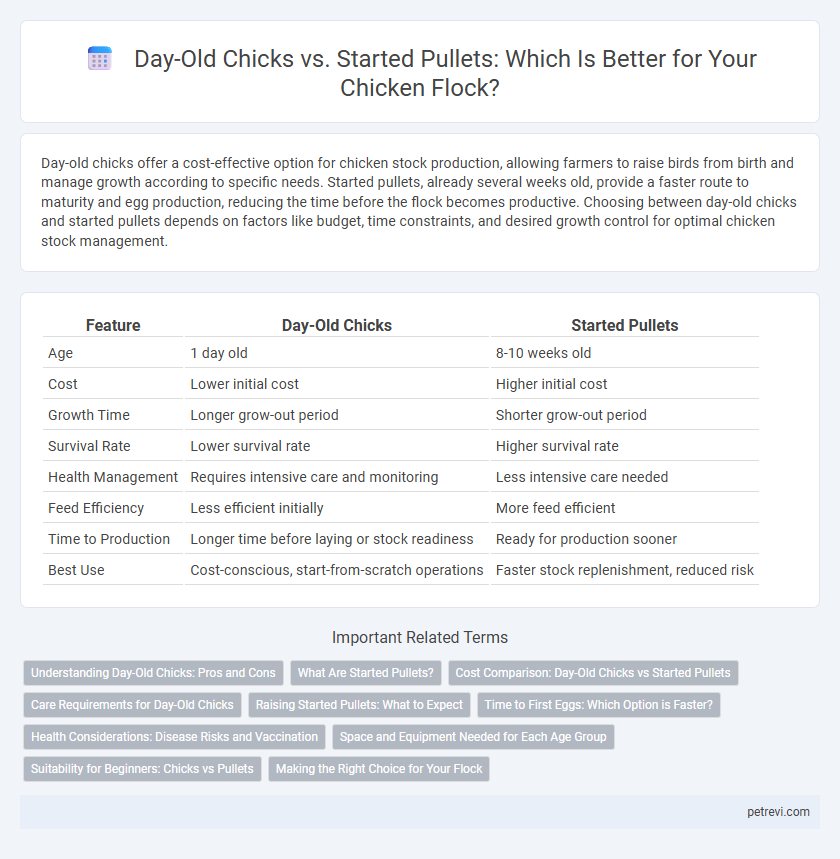Day-old chicks offer a cost-effective option for chicken stock production, allowing farmers to raise birds from birth and manage growth according to specific needs. Started pullets, already several weeks old, provide a faster route to maturity and egg production, reducing the time before the flock becomes productive. Choosing between day-old chicks and started pullets depends on factors like budget, time constraints, and desired growth control for optimal chicken stock management.
Table of Comparison
| Feature | Day-Old Chicks | Started Pullets |
|---|---|---|
| Age | 1 day old | 8-10 weeks old |
| Cost | Lower initial cost | Higher initial cost |
| Growth Time | Longer grow-out period | Shorter grow-out period |
| Survival Rate | Lower survival rate | Higher survival rate |
| Health Management | Requires intensive care and monitoring | Less intensive care needed |
| Feed Efficiency | Less efficient initially | More feed efficient |
| Time to Production | Longer time before laying or stock readiness | Ready for production sooner |
| Best Use | Cost-conscious, start-from-scratch operations | Faster stock replenishment, reduced risk |
Understanding Day-Old Chicks: Pros and Cons
Day-old chicks offer a lower initial cost and greater flexibility for poultry farmers to raise chickens according to their specific management practices and goals. However, these chicks require intensive early care, including temperature control, nutrition, and protection from disease, which can increase labor and resource demands. Understanding the balance between affordability and the intensive care required is essential for optimizing chicken stock production.
What Are Started Pullets?
Started pullets are young hens that have been raised for 6 to 8 weeks with a regulated diet and environment, making them hardier and more developed than day-old chicks. They are typically vaccinated, accustomed to feed and water systems, and ready to integrate into a flock with less initial care. Using started pullets reduces early mortality and accelerates productivity in chicken stock management.
Cost Comparison: Day-Old Chicks vs Started Pullets
Day-old chicks generally cost significantly less per bird than started pullets, making them a more budget-friendly option for large-scale poultry production. However, started pullets, already being 16 to 20 weeks old and vaccinated, reduce the time and resources spent on brooding and early care, potentially lowering overall rearing costs despite their higher initial price. Evaluating feed consumption, labor, and mortality rates alongside purchase price is essential for a comprehensive cost comparison between day-old chicks and started pullets in chicken stock management.
Care Requirements for Day-Old Chicks
Day-old chicks require a carefully controlled environment with consistent warmth of 90-95degF during the first week, gradually reducing as they grow to avoid chilling or overheating. Their diet should consist of high-protein starter feed, typically around 20-24% protein, to support rapid growth and immune system development. Clean water, ample space, and vigilant monitoring for signs of stress or disease are essential to ensure healthy development before transitioning to the general flock.
Raising Started Pullets: What to Expect
Raising started pullets offers faster growth with birds typically 8 to 12 weeks old, providing a head start compared to day-old chicks by shortening the brooding phase. Pullets have already developed essential behaviors like feeding and socializing, reducing early mortality rates and easing management challenges. Expect more uniform flock growth and earlier egg production, which improves overall efficiency for chicken stock operations.
Time to First Eggs: Which Option is Faster?
Day-old chicks typically take around 18 to 22 weeks to start laying eggs, while started pullets are usually 12 to 16 weeks old and begin egg production within just a few weeks after arrival. Choosing started pullets significantly reduces the time to first eggs, allowing for quicker egg production and faster return on investment. Time-saving advantages make started pullets the preferred option for immediate egg supply compared to raising day-old chicks from scratch.
Health Considerations: Disease Risks and Vaccination
Day-old chicks require stringent biosecurity measures to mitigate disease risks such as Marek's disease and avian influenza, with vaccination protocols commonly applied at hatcheries to enhance early immunity. Started pullets, typically aged 12 to 16 weeks, often have completed initial vaccinations like Newcastle disease and Infectious Bronchitis, reducing immediate health risks upon integration. Monitoring health status and ensuring vaccinations align with local disease prevalence are critical for maintaining flock productivity and minimizing mortality.
Space and Equipment Needed for Each Age Group
Day-old chicks require minimal initial space with brooder boxes, heat lamps, and feeders to maintain optimal temperature and growth conditions. Started pullets need more spacious coops with perches, nesting boxes, and waterers designed for juvenile chickens nearing maturity. Proper equipment scaling is crucial for preventing overcrowding and promoting healthy development in each growth stage.
Suitability for Beginners: Chicks vs Pullets
Day-old chicks require more intensive care, including regulated warmth, frequent feeding, and careful monitoring, making them less suitable for beginners in chicken stock management. Started pullets, typically 16-20 weeks old and already acclimated to the environment with established feeding routines, offer a lower-maintenance option ideal for novices. Choosing started pullets reduces early-stage mortality risk and simplifies flock integration, enhancing beginner success in poultry keeping.
Making the Right Choice for Your Flock
Day-old chicks offer a cost-effective option but require more intensive care and time to reach maturity, while started pullets come partially grown and vaccinated, reducing early risks and management efforts. Evaluating factors such as flock size, available resources, and experience level helps determine the best choice for sustainable chicken stock development. Selecting the right bird type directly influences feed conversion, mortality rates, and overall flock productivity.
Day-Old Chick vs Started Pullets for Chicken Stock Infographic

 petrevi.com
petrevi.com